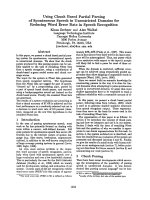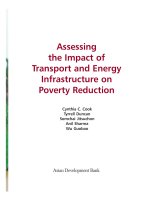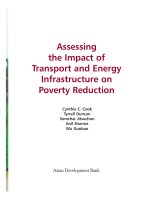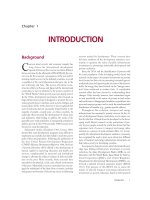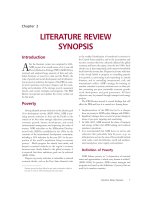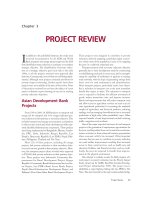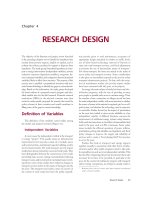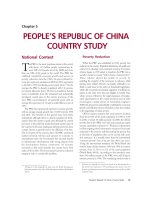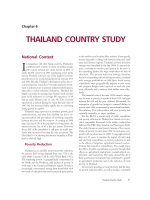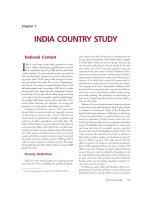Assessing the impact of exact reads on reducing the error rate of read mapping
Bạn đang xem bản rút gọn của tài liệu. Xem và tải ngay bản đầy đủ của tài liệu tại đây (1.92 MB, 15 trang )
(2018) 19:406
Salari et al. BMC Bioinformatics
/>
METHODOLOGY ARTICLE
Open Access
Assessing the impact of exact reads on
reducing the error rate of read mapping
Farzaneh Salari1 , Fatemeh Zare-Mirakabad1,2* , Mehdi Sadeghi3 and Hassan Rokni-Zadeh4
Abstract
Background: Nowadays, according to valuable resources of high-quality genome sequences, reference-based
assembly methods with high accuracy and efficiency are strongly required. Many different algorithms have been
designed for mapping reads onto a genome sequence which try to enhance the accuracy of reconstructed genomes.
In this problem, one of the challenges occurs when some reads are aligned to multiple locations due to repetitive
regions in the genomes.
Results: In this paper, our goal is to decrease the error rate of rebuilt genomes by resolving multi-mapping reads. To
achieve this purpose, we reduce the search space for the reads which can be aligned against the genome with
mismatches, insertions or deletions to decrease the probability of incorrect read mapping. We propose a pipeline
divided to three steps: ExactMapping, InExactMapping, and MergingContigs, where exact and inexact reads are
aligned in two separate phases. We test our pipeline on some simulated and real data sets by applying some read
mappers. The results show that the two-step mapping of reads onto the contigs generated by a mapper such as
Bowtie2, BWA and Yara is effective in improving the contigs in terms of error rate.
Conclusions: Assessment results of our pipeline suggest that reducing the error rate of read mapping, not only can
improve the genomes reconstructed by reference-based assembly in a reasonable running time, but can also have an
impact on improving the genomes generated by de novo assembly. In fact, our pipeline produces genomes
comparable to those of a multi-mapping reads resolution tool, namely MMR by decreasing the number of
multi-mapping reads. Consequently, we introduce EIM as a post-processing step to genomes reconstructed by
mappers.
Keywords: Reference-based assembly, Read mapping, Multi-mapping reads
Background
The advent of next generation sequencing (NGS) technologies by greatly increasing the volume of produced
data, created a genomic revolution. Massive amount of
data and low cost of these technologies make it possible to determine large parts of a genome sequence in
a short time. Today, biological research on any organism from viruses and bacteria to humans depends on
the genome sequence information. In addition, sequences
of organisms have an important role in understanding
diseases.
*Correspondence:
Mathematics and Computer Science Department, Amirkabir University of
Technology (Tehran polytechnic), Tehran, Iran
2
School of Biological Science, Institute for Research in Fundamental Sciences
(IPM) P.O. Box: 19395-5746, Tehran, Iran
Full list of author information is available at the end of the article
1
In order to reconstruct a genome sequence based on
NGS data, genome assembly, one of the challenging problems in bioinformatics, is defined. There are two different approaches to model genome assembly: de novo
and reference-based assembly. In the first model, a novel
genome sequence is reconstructed from scratch by only
applying NGS reads. In the second one, a reference
genome is employed to assemble the NGS reads by mapping them onto the reference.
Because of the large volume of NGS reads, established
alignment algorithms such as Smith-Waterman aren’t efficient for read mapping. To reduce search space, several
algorithms have been developed [1–5] using the seedand-extending approach in which the reads are mapped
onto the reference in two main steps. Firstly, some subsequences of each read are selected as seeds to find their
© The Author(s). 2018 Open Access This article is distributed under the terms of the Creative Commons Attribution 4.0
International License ( which permits unrestricted use, distribution, and
reproduction in any medium, provided you give appropriate credit to the original author(s) and the source, provide a link to the
Creative Commons license, and indicate if changes were made. The Creative Commons Public Domain Dedication waiver
( applies to the data made available in this article, unless otherwise stated.
Salari et al. BMC Bioinformatics
(2018) 19:406
positions in the reference. In this way, the candidate locations of the reads are determined rapidly. Secondly, each
read is aligned to its candidate locations by a dynamic
programming algorithm in order that the actual mapping
positions are obtained.
During the past years, various algorithms have been
designed to improve the accuracy and efficiency of
mappers [6–13]. Although these algorithms represent
appropriate approaches to reduce the time and space
complexity, resolving multi-mapping reads in genome
reconstruction has remained a challenge. Due to repetitive regions within the genome, some reads can be
mapped to multiple locations of the reference genome.
Multi-mapping reads may be aligned at incorrect locations since the read set contains sequencing errors and
genetic variations relative to the reference. As a result,
some errors such as mismatches and indels (insertions or
deletions) are introduced to the reconstructed genome.
Read mappers often randomly select one of the locations
for a multi-mapping read as the primary one. Recently,
a post-processing tool (MMR) has been developed [14]
to find optimal locations for multi-mapping reads within
DNA- and RNA-seq alignment results. It resolves the
problem based on the assumption of aligned reads coverage uniformity.
In this study, we introduce a new view to resolving multi-mapping reads by increasing the rate of reads
aligned uniquely to the reference in order to decrease the
error rate of the reconstructed genome sequence. For this
aim, we divide the reads into two groups in accordance
with the reference genome. The idea is inspired by the
following fact.
Consider a target genome (the genome from which a set
of reads is sampled) which is highly similar to the respective reference genome. If the read set is mapped onto the
reference, high percentage of the reference can be covered by the reads uniquely aligned without mismatches
and indels (exact reads). Leftover alignable reads (inexact
reads) are then mapped to the remaining parts of the reference. Therefore, to reconstruct most of the target genome,
it is enough to find the locations of reads which have
unique exact-matching with the reference. The rest of the
target genome can be rebuilt by aligning remaining reads
against the reference with mismatches and indels.
Most of the existing read mappers don’t consider any
differences between the mapping of exact and inexact
reads. For example, hash-based mappers find seeds which
support mismatches (space-seeds) and gaps on the whole
reference genome for all reads [15]. On the one hand,
consecutive seeds are enough for exact reads and using
space-seeds leads to excessive memory consumption. On
the other hand, inexact reads are aligned by finding candidate locations on the whole reference genome, while
according to high similarity between a target genome and
Page 2 of 15
its reference, searching in small parts of the reference is
sufficient to find these types of reads.
Based on defining reads in two types: exact and inexact reads, we present a pipeline (EIM - mapping Exact
and Inexact reads separately and then Merging the constructed contigs) for resequencing of a genome. To assess
our pipeline, we have chosen Bowtie2 [7] as a highly
cited and user-friendly mapper and used some real and
simulated read sets. For a more complete evaluation of
EIM pipeline, two other mappers are also used. Our
results illustrate that EIM pipeline improves the quality of
genomes reconstructed by the mappers in terms of error
rate and yields comparable results to MMR in reducing
errors.
Methods
Let S = s1 s2 . . . sL denote a DNA sequence in
which ∀1≤i≤L si ∈ {A, C, G, T, N}; and |S| denote
the length of S. A genome sequence is a long DNA
sequence. A set of paired reads is defined as R =
{ r1 , r1 , r2 , r2 , . . . , rm , rm } where for each i, ri and ri are
short DNA sequences with length of k.
We propose a three-step pipeline (Fig. 1) for referencebased assembly as below, where a set of paired reads R and
a genome sequence G are given as inputs:
i. ExactMapping
The set of reads is mapped onto the genome
sequence without mismatches and indels. Then an
exact contig set called Cng1 is generated from
uniquely mapped reads.
ii. InExactMapping
The remaining reads from previous step are mapped
onto the regions of the genome which are covered
with no contigs of Cng1 to construct an inexact
contig set named Cng2.
iii. MergingContigs
The two contig sets, Cng1 and Cng2 are merged to
build up ultimate contigs.
In the following, each step of EIM pipeline is described
in detail.
ExactMapping
In this step, we should apply a mapper to align the set of
reads with the genome without mismatches and indels. In
this regard, the genome G and the read set R are given
to the mapper as inputs. After running the mapper, two
outputs are produced: i) set R ⊂ R containing unmapped
and multi-mapping reads ii) SAM file [16] including the
information of the alignment. Then consensus sequence
C is built up from uniquely mapped reads in the SAM file,
where C is a DNA sequence with length |G|. Afterwards,
a set of contigs called Cng1 is generated by breaking the
sequence C at each position of ‘N’.
Salari et al. BMC Bioinformatics
(2018) 19:406
Page 3 of 15
InExactMapping
In this stage, genome sequence G = g1 g2 . . . gn is modified
based on consensus sequence C = c1 c2 . . . cn to generate
a new genome called GM . To construct genome GM , the
following steps are taken:
1: Make sequence C = c1 c2 . . . cn as follows:
ci =
N ci ∈ {A, C, G, T},
gi ci = N,
where C contains all parts of genome G covered with
no contigs of Cng1.
2: Generate sequence GM = g1M g2M . . . gnM by extending
each contiguous nucleic acid sequence as:
giM
⎧
⎨ ci ci ∈ {A, C, G, T},
= gi ci = N&∃kj=1 ci±j ∈ {A, C, G, T},
⎩
N o.w,
where k is equal to the read length.
Then GM is broken at each position of ‘N’, and as a result
a set of contigs is obtained. After that, a mapper is used
in order to align R against the set of contigs with mismatches and indels. Finally, a consensus sequence is made
from mapped reads in the SAM file for each contig and
added to Cng2.
MergingContigs
Fig. 1 EIM pipeline overview and applied tools. The first step has
three outputs: leftover reads (R ), modified remaining parts of the
genome sequence (GM ) and exact contigs (Cng1). The output of the
second step is inexact contig set indicated by Cng2. Currently, EIM
can apply one of mappers Bowtie2 [7], BWA [8, 9] and Yara [10] for
mapping reads
In this part, the two contig sets Cng1 and Cng2 generated respectively at the steps of ExactMapping and InExactMapping, are combined to rebuild the target genome.
Although Cng1 contains large contigs which make up
most of the target genome, Cng2 is required to produce
larger contigs including the differences with genome G.
We merge the contig sets without alignment because the
positions of contigs relative to the genome G are known.
In this way, every two contigs of Cng1 are joined by a
contig of Cng2 overlapping with both of them. Merging
method is described in more detail below.
The union of Cng1 and Cng2 contig sets is defined
as Cng = ≺ Di , si , ei , t i | Di = d1i d2i · · · dei i −si +1 where
for each i, Di is a contig belonging to either Cng1 or Cng2.
The start and end positions of contig Di on the reference
are shown by si and ei , repectively. It should be noted that
si < si+1 and ei < ei+1 . Moreover, the value of t i is set to
1 (or 2) when Di ∈ Cng1 (or Di ∈ Cng2). In the following,
all the contigs in Cng are merged by a recursive equation:
Salari et al. BMC Bioinformatics
mi =
(2018) 19:406
⎧
∅
⎪
⎪
⎪
⎪
⎨ mi−1 · Di
i = 0,
1 ≤ i ≤ |Cng|& t i = 1, (1a)
mi−1 · d1i d2i · · · di
(e −s +1)−k
⎪
i
i
i
⎪
dk+2
· · · d(e
mi−1 · dk+1
⎪
i −si +1)−k
⎪
⎩ i−1 i i
i
m
Page 4 of 15
i
i
· dk+1 dk+2 · · · d(ei −si +1)
i = 1&t i = 2,
1
|Cng|&t i
(1b)
= 2,
i = |Cng|&t i = 2,
(1c)
(1d)
where k is equal to the length of a read, and |Cng| is the
number of contigs in the Cng set. For each i, mi denotes
the merged sequence achieved by combining D1 to Di .
Part (1a) of the above equation shows that each contig of Cng1 has to be completely inserted to the merged
sequence as it is highly probable that the contig has been
made correctly. Parts (1b), (1c) and (1d) indicate how
to insert a contig of Cng2 to the merged sequence after
removing the extended parts (with length of k). The ultimate merged sequence is represented by m|Cng| which may
include some Ns because of Cng2 contigs. Thus m|Cng|
sequence is broken at each position of ‘N’ for generating
output contigs of EIM pipeline.
Datasets
Several real and simulated datasets are used to evaluate
the accuracy of EIM pipeline. The first real dataset is an
Illumina MiSeq pair-end read set from E. coli downloaded
from [17, 18] which consists of about 1.5 million paired
reads of 151 base-pair (bp) with coverage depth 100×.
We apply Escherichia coli str. K12 substr. MG1655 [GenBank:NC_000913] as a reference genome and Escherichia
coli O145:H28 str. RM12581 [GenBank: CP007136.1] as a
related strain.
The second dataset includes four human chromosome
read sets: Chr1, Chr10, Chr14 and Chr21 extracted
from samples. The whole human genome samples are
downloaded from the SRA database of National Center for Biotechnology Information (NCBI) with accession
numbers SRR67780, SRR67785, SRR67787, SRR67789,
SRR67791, SRR67792, SRR67793. The human reference
genome GRCh38 is downloaded from [19]. All read sets
contain 101 bp paired reads with the properties shown in
Table 1.
We simulate several read sets for a prokaryotic and
eukaryotic genome: E. coli and Arabidopsis thaliana.
To simulate reads for E. coli, we create four genome
sequences, E. coli-Mut1 to E. coli-Mut4 derived from E.
coli K12. Then Illumina read sets, ReadSet1 to ReadSet8
and ReadSet9 to ReadSet12 are simulated for mutated
Table 1 Real data sets properties
Data set
GenomeLength
Reads#
Coverage
Human Chr 1
248, 956, 422
80, 623, 200
34×
Human Chr 10
133, 797, 422
45, 121, 800
34×
Human Chr 14
107, 349, 540
36, 117, 398
42×
Human Chr 21
46, 709, 983
18, 941, 800
42×
genomes by DWGSIM [20] and ART [21], respectively. E.
coli-Mut1 and E. coli-Mut2 have single nucleotide variants (SNVs) with the rate of 0.1%. E. coli-Mut2 has SNVs
of random size among 1 to 3. E. coli-Mut3 has SNVs and
deletions of the rates 0.09% and 0.01% respectively. E. coliMut4 has SNVs and insertions of the rates 0.09% and
0.01% respectively. The read sets, ReadSet1 to ReadSet4
are simulated such that the length and coverage depth of
the reads are similar to those of the real read set from E.
coli K12 genome (i. e. more than 1.5 million paired reads
of 150 bp). The read sets, ReadSet5 to ReadSet12 are simulated with low coverage (i. e. about 3000 paired reads of
150 bp) and sequencing error. The properties of simulated
reads are shown in Table 2.
To generate reads for Arabidopsis thaliana, we create
a genome sequence derived from TAIR10 [GenBank:
CP002684.1-CP002688.1] reference genome. Firstly,
TAIR10 genome sequence is mutated based on bur-0
strain variations obtaining from [22]. Then an Illumina
read set including 15.6 million paired reads of 150
bp with coverage depth of 20× is simulated by ART
simulator.
Tools
Some tools are utilized for running EIM pipeline as
follows. We use DWGSIM [20] and ART [21] for simulating reads, Bowtie2, Yara [10] and BWA [8, 9] for
mapping reads, and SAMtools [16] for making consensus sequences. We also implement a simple hash-based
aligner called ExactMapper for mapping reads without
mismatches and gaps to make the pipeline faster.
The assessments on large genomes including human
chromosomes and Arabidopsis thaliana are performed
on a desktop which has a 3.60GHz Intel(R) Core(TM)
i7 − 6850K 6-core processor and 32GB of RAM running
64-bit Ubuntu 18.04 LTS. The other assessments are performed on a laptop with an Intel(R) Core(TM) i7 − 3517U
processor and 8GB of RAM running 64-bit Ubuntu 15.10.
At ExactMapping step, we apply ExactMapper aligner
for small genomes to generate a SAM file and extract
remaining reads (unmapped and multi-mapping reads)
simultaneously. Next, SAM file is given to a script to build
up a consensus sequence C from uniquely mapped reads.
At InExactMapping step, we employ one of the aforementioned mappers with appropriate parameters and then
construct the consensus sequence by SAMtools. For this
purpose, The ‘--keep-masked-ref ’ parameter is set for
‘bcftools call’ command of SAMtools to be able to make
consensus in IUPAC positions of the reference genome.
It should be noted, for large genomes such as the human
chromosome 14, we use Bowtie2 in ExactMapping step.
The ‘--score-min’ parameter of Bowtie2 is set to the value
‘C, 0, −1’ to only map the reads with exact matches to
the genome. Th unmapped and multi-mapping reads are
Salari et al. BMC Bioinformatics
(2018) 19:406
Page 5 of 15
Table 2 Simulated data sets properties
Data set
Target genome
Genome length
Indel+SNV %
# SNVs
# Insertions
# Deletions
Read length
Coverage
Simulator
ReadSet1
E. coli-Mut1
4639675
0.1
4640
0
0
150
100×
DWGSIM
ReadSet2
E. coli-Mut2
4639675
0.1
4640
0
0
150
100×
DWGSIM
ReadSet3
E. coli-Mut3
4639138
0.1
4205
0
537
150
100×
DWGSIM
ReadSet4
E. coli-Mut4
4640180
0.1
4135
505
0
150
100×
DWGSIM
ReadSet5
E. coli-Mut1
4639675
0.1
4640
0
0
150
20×
DWGSIM
DWGSIM
ReadSet6
E. coli-Mut2
4639675
0.1
4640
0
0
150
20×
ReadSet7
E. coli-Mut3
4639138
0.1
4205
0
537
150
20×
DWGSIM
ReadSet8
E. coli-Mut4
4640180
0.1
4135
505
0
150
20×
DWGSIM
ReadSet9
E. coli-Mut1
4639675
0.1
4640
0
0
150
20×
ART
ReadSe10
E. coli-Mut2
4639675
0.1
4640
0
0
150
20×
ART
ReadSet11
E. coli-Mut3
4639138
0.1
4205
0
537
150
20×
ART
ReadSet12
E. coli-Mut4
4640180
0.1
4135
505
0
150
20×
ART
extracted from the SAM file by a script and the consensus
sequence is constructed by SAMtools.
Evaluation metrics
To evaluate EIM pipeline, we calculate some contiguity and quality metrics by QUAST [23] for contig sets
(genomes) reconstructed by ExactMapping step, EIM and
the mappers.
We use two metrics to compare the contiguity of the
contig sets as follows:
• Contigs-500: The number of contigs with length of
greater than 500 bp belonging to the contig set.
• N50: The length of the smallest contig in the set that
contains the fewest (largest) contigs whose combined
length represents at least 50% of assembly [24].
We use quality metrics for indicating the accuracy of
the reconstructed genomes. To calculate some quality
metrics, each set of contigs is aligned to the target (or reference) genome to find the number of errors regarding to
each contig set as below:
• Errors: The total number of mismatches and indels
(insertions and deletions) in the aligned contigs
relative to the target genome.
• IUPAC-codes: The total number of IUPAC
ambiguity positions in the contig set.
• Genome-Fraction: The percentage of the target (or
reference) genome covered by the aligned contigs.
when the target genome is not available, we apply the
following quality measure to test the accuracy of the
reconstructed genomes.
• Remapped-Reads: The percentage of the reads
which are identically mapped (i.e. without
mismatches and indels) onto the contigs.
Results
A set of reads and a reference genome are given to EIM
pipeline as inputs and then EIM constructs a set of contigs as output by stepwise mapping of the reads onto
the reference. The sequencing errors and genetic differences as well as repetitive regions in the genome are
the factors which introduce mapping errors such as mismatches and indels into the contigs relative to the target
genome.
To evaluate the results of EIM pipeline, we use different datasets in terms of similarity between the target and
reference genomes as follows:
1. By considering a reference genome identical to the
target genome, we initially assess our pipeline where
the real read set from E. coli K12 includes
sequencing errors.
2. According to the high similarity between any human
genome and the human reference, we investigate
results of EIM pipeline where the real reads from a
human chromosome 14 contain sequencing errors as
well as SNVs. It is to be noted that the target genome
is not available.
3. By simulating some target genomes highly similar to
E. coli K12 genome, we examine EIM pipeline in
which the simulated reads include SNVs. In this way,
we can test the accuracy of EIM more precisely since
the target genomes are available.
4. By using a closely related genome to E. coli K12 as a
reference, we perform EIM pipeline on a real read set
from E. coli K12 to assess our pipeline where the
similarity between the target and reference genomes
is not very high.
For completing the evaluation of EIM, we apply different
mappers on a real read set from E. coli K12 and a closely
related genome to it as a reference, and then compare the
(2018) 19:406
Salari et al. BMC Bioinformatics
Page 6 of 15
results of EIM pipeline to the respective mappers. In addition, we evaluate our pipeline on eukaryotic genomes of
human and Arabidopsis thaliana.
Assessment of EIM on a real dataset of E. coli K12
To test the accuracy of EIM, we examine the effect of
sequencing errors without considering any other factors.
For this purpose, E. coli K12 genome and its reads generated by using Illumina are given to EIM as inputs. Accordingly, the target and reference genomes are the same and
the read set includes sequencing errors.
An Illumina sequencer has an error rate of < 0.1%
[25], because of which only 61.79% of the reads can be
mapped at the first step of EIM pipeline (ExactMapping).
However, contigs constructed from the uniquely mapped
reads cover nearly entire of the target genome (99.995% in
Table 3). At the second step of our pipeline (InExactMapping), remaining reads from the first step are mapped onto
just 0.005% of the reference. As shown in Table 3, the
last step of EIM (MergingContigs) produces a contiguous
contig including 2 errors, while Bowtie2 mapper makes
11 contigs containing the same number of errors on this
sample data. Although Bowtie2 generates more contigs
than EIM, the Genome-Fraction values of both contig sets
are the same (100%) because the gaps between contigs of
Bowtie2 are too small compared to the total length of the
target genome.
This assessment shows that contig sets reconstructed by
EIM and Bowite2 are the same in terms of accuracy when
the read set contains sequencing errors.
Assessment of EIM on a real dataset of human
chromosome 14
Assessment of EIM on simulated data
In this assessment, our goal is to investigate the accuracy
of EIM where the set of reads extracted from a genome
Table 3 Real datasets analysis where the inputs of EIM pipeline
are the read set and reference genome
Assembly
includes sequencing errors as well as SNVs and indels relative to the reference. We perform EIM on the human
chromosome 14 reference and the reads from a human
chromosome 14.
Due to sequencing errors and genetic differences
between human genomes, only about half of reads
(58.33%) are aligned at the ExactMapping step. The contigs constructed from this volume of the reads cover
93.22% of the chromosome 14 reference (Table 3). Furthermore, the results presented in Table 3 show that
EIM makes significantly fewer contigs than Bowtie2. In
other words, the comparison of N50 values indicates that
EIM can make a contig set more contiguous than that
of Bowtie2. Moreover, the contigs of EIM include fewer
errors relative to the reference than those of Bowtie2.
Although comparing with the reference genome gives
insight into the error rate of the reconstructed genomes,
some differences are true differences rather than errors.
Since the target genome is not available, we use the read
set to assess the accuracy of EIM. In this way, the reads
are mapped without mismatches and indels to the reconstructed genomes to calculate Remapped-Reads values.
The results of the remapping show that the RemappedReads values for the genomes reconstructed by EIM and
Bowtie2 are 60.87% and 58.68% respectively. This is an
appropriate evidence that the reconstructed genome by
EIM is more accurate than that of Bowtie2.
Our results show that when the target and reference
genomes are highly similar, EIM pipeline can reconstruct
a more accurate genome than the one rebuilt by Bowtie2
mapper.
Exact
EIM
Bowtie2
Contigs-500
64
1
11
N50 (kbp)
1250.9
4639.673
597.8
Errors
0
2
2
Genome-Fraction (%)
99.995
100
100
Contigs-500
27312
451
1179
N50 (kbp)
6
407.6
174.1
Errors
18
44407
44911
Genome-Fraction (%)
93.22
99.80
99.71
E. coli
Human chromosome 14
The evaluation metrics has been defined in the text. The columns headed ’Exact’,
’EIM’ and ’Bowtie2’ represent the contiguity and quality of contigs constructed by
ExactMapping step of EIM, EIM and Bowtie2, respectively
To assess the accuracy of EIM more precisely, the target
genome sequences are required. Since target sequences
are typically not available for most of individuals and
strains, we use simulated data. To do so, we make some
genome sequences derived from E. coli K12 genome
by creating mismatches and indels using different rates
and then simulate read sets from the mutated genomes
(Table 2).
We test EIM pipeline on ReadSet1 (Table 2) and E. coli
K12 as a reference genome. To compare contigs generated by EIM and Bowtie2 , we align both contig sets
against E. coli-Mut1 (the target genome) and present the
results in the second, third and last columns of Table 4.
Although EIM pipeline rebuilds a contiguous contig, it
introduces more errors than Bowtie2. It is also worth
mentioning that the contigs of ExactMapping step of EIM
called Exact contigs have 90.285% Genome-Fraction value
which in comparison with that obtained by real data
experiment (99.995% in Table 3) is very low. It seems that
a lower Genome-Fraction value of Exact contigs leads to
the higher errors in the final contigs produced by EIM.
Salari et al. BMC Bioinformatics
(2018) 19:406
Page 7 of 15
Table 4 Simulated ReadSet1 analysis where the inputs of EIM
pipeline are the read set and either the reference genome (ref) or
the genome reconstructed by Bowtie2 (cns-bt)
c1
c2
Assembly
c3
c4
c5
Exact EIM
Exact
EIM (v1) EIM (v2) Bowtie2
/ref
/ref
/cns-bt /cns-bt /cns-bt / ref
Contigs-500
2817
1
68
9
2
6
N50 (kbp)
1.82
4639.6 156.4
1108.9
3543.3
2385.650
Errors
3
45
28
29
38
99.999
100
Genome-Fraction (%) 90.285 100
0
99.381 99.992
c6
c7
The evaluation metrics has been defined in the text. The columns headed
’Exact/ref’, ’EIM/ref’, ’EIM (v1)/cns-bt’, ’EIM (v2)/cns-bt’ and ’Bowtie2’ represent the
contiguity and quality of the respective contigs. Also E. coli K12 genome is denoted
by ’ref’ and the consensus sequence constructed by Bowtie2 on E. coli genome is
denoted by ’cns-bt’
We need to point out that the more fraction of the target genome is covered by Exact contigs, the smaller parts
of the reference remain for InExactMapping step of EIM.
Hence the probability that the leftover reads are aligned at
true locations is increased and as a result, the error rate
of the reconstructed genome is reduced. Furthermore, the
fraction of the target genome covered by Exact contigs is
directly proportional to the similarity between the target
and reference genomes. In other words, the higher similarity between the target and reference genomes leads to
fewer errors in the genome reconstructed by EIM pipeline.
Accordingly, since the genome sequence reconstructed by
a mapper is more similar to the target genome than to
the reference (ref ), the genome sequence reconstructed by
Bowtie2 (cns-bt) is fed to EIM instead of the reference as
input.
The results can be seen in the fourth and fifth
columns of Table 4. The comparison of the second
and fourth columns shows that by giving the genome
sequence reconstructed by Bowtie2 instead of the reference sequence to EIM as the input, the Genome-Fraction
value of Exact contigs increases from 90 to >99%. In
addition, the number of errors in final contigs of EIM
decreases from 45 to 28. It suggests that the genome
sequence reconstructed by a mapper is a better input for
our pipeline as it leads to a lower error rate. Our analysis up to this point shows that by feeding cns-bt instead of
ref to EIM pipeline as input, the error rate is reduced. It
is important to note that the error rate decreasing is valuable only when EIM rather maintains the same N50 and
Genome-Fraction values as those of the input genome.
However, the results of EIM in the fifth column compared
to the last column of Table 4 indicate that this condition is
not satisfied.
We observed that cns-bt includes 137 IUPAC-codes
while ref contains no IUPAC-codes. Furthermore, the
genome reconstructed by mapping a read set onto a
reference sequence containing IUPAC-codes is less
contiguous than the reference because SAMtools makes
a consensus sequence including ‘N’ in the IUPAC-code
positions. Thus the existence of IUPAC-codes in the input
genome of EIM yields a more fragmented genome as output. To solve this issue, we execute SAMtools with a
parameter allowing to build consensus in the IUPAC-code
positions instead of substituting ‘N’ ambiguity character
(“Tools” subsection). As shown in the sixth column of
Table 4, EIM with this modification makes contigs which
in addition to including less errors than cns-bt (the input
genome), are nearly as contiguous as cns-bt and with
high coverage of the target genome. In the following, EIM
described in the fifth and sixth columns of Table 4 are
considered as versions one (v1) and two (v2), respectively.
Tables 5 and 6 represent the results of applying EIM
(v2) pipeline and Bowtie2 mapper to the simulated read
Table 5 Simulated high coverage datasets analysis where the
inputs of EIM pipeline are the read set and genome
reconstructed by Bowtie2
Exact
EIM (v2)
Contigs-500
68
2
6
N50 (kbp)
156.4
3543.3
2385.6
Errors
0
29
38
IUPAC-codes
0
11
137
Genome-Fraction (%)
99.381
99.999
100
142
3
5
N50 (kbp)
62.7
1371.6
939.1
Errors
0
45
92
IUPAC-codes
0
29
246
Genome-Fraction (%)
99.338
100
99.997
Contigs-500
96
6
3
N50 (kbp)
94.4
1096.2
3267.7
Errors
2
54
87
IUPAC-codes
0
11
140
Genome-Fraction (%)
99.285
99.997
100
Contigs-500
77
3
3
N50 (kbp)
115.5
2337.4
1530.2
Errors
6
55
72
IUPAC-codes
0
15
34
Genome-Fraction (%)
99.436
99.998
100
Assembly
Bowtie2
ReadSet1
ReadSet2
Contigs-500
ReadSet3
ReadSet4
The evaluation metrics has been defined in the text. The columns headed ’Exact’,
’EIM (v2)’ and ’Bowtie2’ represent the contiguity and quality of contigs constructed
by ExactMapping step of EIM, EIM (v2) and Bowtie2, respectively
Salari et al. BMC Bioinformatics
(2018) 19:406
Page 8 of 15
Table 6 Simulated low coverage datasets analysis where the inputs of EIM pipeline are the read set and genome reconstructed by
Bowtie2
Assembly
Exact
EIM (v2)
Bowtie2
DWGSIM simulator
ART simulator
ReadSet5
ReadSet9
Exact
EIM (v2)
Bowtie2
Contigs-500
172
14
58
137
13
56
N50 (kbp)
43.9
735.7
159.6
75.2
909.5
175.3
Errors
0
53
64
1
45
53
IUPAC-codes
0
36
137
0
38
102
Genome-Fraction (%)
98.899
99.991
99.983
98.912
99.983
99.965
ReadSet6
ReadSet10
Contigs-500
163
6
64
178
18
63
N50 (kbp)
44.4
1698.5
112.2
45.4
485.2
116.9
Errors
1
68
92
2
68
83
IUPAC-codes
0
28
95
0
39
187
Genome-Fraction (%)
98.843
99.998
99.976
98.871
99.988
99.984
ReadSet7
ReadSet11
Contigs-500
424
11
55
425
17
70
N50 (kbp)
16.6
590.9
125.9
18
386.6
115.4
Errors
2
185
361
6
179
369
IUPAC-codes
0
24
117
0
38
151
Genome-Fraction (%)
98.666
99.993
99.985
98.697
99.989
99.983
ReadSet8
ReadSet12
Contigs-500
397
17
56
366
13
49
N50 (kbp)
18.9
493.4
141.1
21.6
529.5
127.6
Errors
8
190
331
8
186
322
IUPAC-codes
0
21
105
0
23
121
Genome-Fraction (%)
98.771
99.99
99.979
98.799
99.983
99.982
The evaluation metrics has been defined in the text. The columns headed ’Exact’, ’EIM (v2)’ and ’Bowtie2’ represent the contiguity and quality of contigs constructed by
ExactMapping step of EIM, EIM (v2) and Bowtie2, respectively. The results of running the pipeline on datasets simulated by DWGSIM and ART are shown in left and right side
of the table, respectively
sets with high and low coverage, respectively. As illustrated by the results, not only can EIM (v2) decrease
the error and IUPAC-code rates, but it can also maintain
the contiguity and Genome-Fraction value very close to
Bowtie2.
The results of this assessment show that our pipeline
can improve the genome sequence reconstructed by
Bowtie2 mapper in terms of accuracy when a highly similar reference to the target genome is available and the read
set includes SNVs relative to the reference.
Assessment of EIM on a real dataset of E. coli K12 and a
closely related genome
In this assessment, we examine the accuracy of EIM when
similarity between the target and reference genomes is
not so high. The application is where a reference is not
available and a closely related genome is used as a reference. We apply E. coli O145:H28 as a closely related
genome to E. coli K12.
To evaluate EIM on the read set from E. coli K12,
a genome sequence is reconstructed from mapping the
reads onto E. coli O145:H28 genome by Bowtie2, then the
reconstructed genome and the reads are given to EIM as
inputs. Table 7 shows that the contig sets generated by
EIM (v1) and EIM (v2) contain fewer errors and IUPACcodes than that of Bowtie2. Moreover, EIM (v2) can make
contigs which have nearly the same Genome-Fraction
value and N50 size as those of Bowtie2.
It should be noticed that the Genome-Fraction values of
the contigs produced by EIM and Bowtie2 are less than
90%. In such cases where there is no reference available
and the related genome is not highly similar to the target
(2018) 19:406
Salari et al. BMC Bioinformatics
Page 9 of 15
Table 7 Real dataset analysis where a closely related genome is used as a reference
Assembly
Exact
EIM (v1)
EIM (v2)
Bowtie2
MaSuRCA
EIM (v1) + MaSuRCA
Contigs-500
497
334
263
259
114
114
N50 (kbp)
12.3
22.2
32
29.3
106
106
Errors
58
618
1190
2472
2407
1786
IUPAC-codes
0
17
56
280
0
5
Genome-Fraction (%)
87.013
87.811
88.578
88.575
99.058
99.058
The evaluation metrics has been defined in the text. The columns headed ’Exact’, ’EIM (v1)’, ’EIM (v2)’, ’Bowtie2’, ’MaSuRCA’ and ’EIM (v1) + MaSuRCA’ represent the
contiguity and quality of contigs constructed by ExactMapping step of EIM, EIM (v1), EIM (v2), Bowtie2, MaSuRCA and combining the contig sets of EIM (v1) and MaSuRCA
assembler, respectively
genome, de novo genome assembly is a better approach
for reconstructing the genome sequence. However, the
genome sequences generated by de novo assemblers are
not error-free. For this reason, approaches for improving
the accuracy of de novo assembled contigs are needed.
Here we use the contigs generated by EIM to improve the
contigs produced by a de novo assembler. In fact, we use
version one of EIM pipeline because contigs of EIM (v1)
include less errors than those of EIM (v2). The read set is
assembled by MaSuRCA [26], one of the best assemblers
at GAGE-B [27], then the contigs constructed by EIM and
MaSuRCA are combined into a contig set including fewer
errors than the contigs of MaSuRCA (Table 7).
This analysis indicates that when a closely related
genome is used as a reference, and thus the reference and
target genomes are not highly similar, EIM (v2) can reconstruct a genome sequence with the same contiguity and
Genome-Fraction value including less errors and IUPACcodes than the genome reconstructed by Bowtie2 mapper.
In addition, the genome rebuilt by EIM (v1) can decrease
the error rate of a genome sequence generated by a de novo
assembler such as MaSuRCA.
runtimes. In addition, the running time of reconstructing a genome by a mapper is the total of read mapping
and consensus constructing runtimes, which the second
one is more time-consuming. Our pipeline decreases the
computational time of making a consensus by a two-step
mapping. In ExactMapping, most of the reads are exactly
aligned and a SAM file is made from which the consensus
sequence can be constructed by a simple and fast script
without using SAMtools. Moreover, only a low percentage of reads is transferred to InExactMapping step and
thus the consensus sequence is made rapidly by SAMtools
in this stage. Consequently, the overhead time of reconstructing the E. coli genome by EIM pipeline after running
a mapper is less than one-third of that of the respective
mapper (Fig. 2e).
This evaluation demonstrates that EIM pipeline can
be used as a post-processing tool to improve the
genome reconstructed by a mapper to a more accurate one in an acceptable runtime while maintaining
the contiguity and Genome-Fraction value of the input
genome.
Evaluation of EIM on de novo assembled genomes
Evaluation of EIM by different mappers
To evaluate the performance of our pipeline by using mappers other than Bowtie2, we select BWA as a popular
and widely used mapper and Yara as one of the state-ofthe-art mappers. We use the three mappers and version
2 of EIM on the read set from E. coli K12 and E. coli
O145:H28 genome as a reference. For each mapper, the
genome reconstructed by the mapper is given to EIM (v2)
as input and the mapper itself is applied for aligning reads
in the second step of EIM (v2) (i. e. InExactMapping).
As illustrated in Fig. 2, for all mappers, EIM pipeline
maintains N50 size and Genome-Fraction value close but
not identical to those of the mappers (Fig. 2a and b). It also
reduces the number of errors and significantly decreases
the number of IUPAC-codes (Fig. 2c and d).
Figure 2e shows the running times of the three mappers compared to EIM. Since the input genome of EIM is
built by a mapper, the running time of reconstructing a
genome by EIM is the total of mapper and EIM pipeline
In this section, we assess the effect of EIM pipeline on
the results of de novo assemblies. For this purpose, we
compare EIM with Pilon framework [28] and Columbus
module of Velvet assembler [29]. These tools get a draft or
reference genome and mapped reads on it, to apply read
mappings for improving genome assembly.
In the following, we first generate two genomes by
Velvet and MaSuRCA assemblers on the real read set from
E. coli K12. Then each draft genome is inputted to EIM,
Pilon, and Columbus.
As illustrated in Fig. 3, all frameworks reduce the number of errors and dramatically decrease the number of
IUPAC-codes when that of the draft genome is too high
(Fig. 3a and b). Although EIM and Columbus decrease
N50 size (Fig. 3c), they maintain Genome-Fraction value
close to those of draft genomes (Fig. 3d).
The results of this comparison show that EIM pipeline
has an impact on reducing the error rate of the genomes
generated by de novo assembly.
Salari et al. BMC Bioinformatics
(2018) 19:406
Page 10 of 15
Fig. 2 The comparison of contigs generated by Bowtie2, Yara and BWA with the respective contigs of EIM on the real read set of E. coli K12. Firstly,
the mappers were executed on the read set and the reference, and then the contig sets were generated. Secondly, for each mapper, EIM (v2) was
run on the read set and the contig set constructed by the mapper while using it at the second step for mapping. Finally, the contiguity and quality
of contigs were computed as a N50 size b Genome-Fraction value c The number of errors d The number of IUPAC codes. In addition, the running
time of obtaining contigs was measured and showed in seconds (e)
Evaluation of EIM on eukaryotic genomes
For the final evaluation, we run EIM pipeline on the
datasets of human as a mammalian and Arabidopsis
thaliana as a model plant. To evaluate EIM on human, we
select the smallest and the largest chromosomes as well as
a chromosome with average length namely Chr21, Chr1,
and Chr10, respectively and extract the reads of each one
from real samples of the whole human genome. Then we
run EIM on each dataset separately. For evaluating our
pipeline on Arabidopsis thaliana, we simulate a dataset for
all chromosomes of bur-0 strain and use TAIR10 as the
reference to run EIM.
Salari et al. BMC Bioinformatics
(2018) 19:406
Page 11 of 15
Fig. 3 The comparison of contigs generated by EIM, Pilon and Columbus on the real read set of E. coli K12.Firstly, two draft genomes were generated
by Velvet and MaSuRCA de novo assemblers. Secondly, EIM, Pilon and Columbus were run by each draft and mapped reads on the draft. Finally, the
quality and contiguity of contigs were computed as a The number of errors b The number of IUPAC codes c N50 size d Genome-Fraction value
As shown in Table 8, EIM pipeline reduces error rates
on all three human chromosomes and bur-0 strain of
Arabidopsis. To be precisely measured the accuracy of
generated contigs, the reads are exactly mapped onto each
contig set to calculate Remapped-Reads value. As seen,
EIM increases Remapped-Reads values. Furthermore, the
results show that our pipeline considerably increases the
N50 size of contig sets generated for human chromosomes
because of the high similarity between human genomes.
In order to examine the effect of different chromosomal
regions on accuracy of EIM, we test our pipeline on portions of a human chromosome. To achieve this goal, we
divide Chr1, the largest human chromosome, to twenty
five same-length regions as follows:
P = {p1 , . . . , p25 } for each i |pi |
10Mbp.
The number of ambiguity characters (Ns) is assessed in
each pi 1 ≤ i ≤ 25 (Fig. 4). We omit p14 because this region
Salari et al. BMC Bioinformatics
(2018) 19:406
Page 12 of 15
Table 8 Evaluating EIM on some eukaryotic datasets
EIM (v2)
Bowtie2
Contigs-500
2497
5018
N50 (kbp)
420.7
158.2
Errors
115381
120726
IUPAC-codes
7862
158247
Genome-Fraction (%)
99.828
99.614
Remapped-Reads (%)
52.02
50.95
Contigs-500
1443
2478
N50 (kbp)
399.9
149.2
Errors
70478
73842
IUPAC-codes
5508
112333
Genome-Fraction (%)
99.209
99.034
Remapped-Reads (%)
51.72
49.93
Assembly
Human chromosome 1
Human chromosome 10
Human chromosome 21
Contigs-500
1239
2362
N50 (kbp)
237.8
101
Errors
22904
23579
IUPAC-codes
3232
46155
Genome-Fraction (%)
99.114
97.73
Remapped-Reads (%)
44.58
42.23
Contigs-500
6936
6987
N50 (kbp)
428.8
417.4
Arabidopsis Thaliana (bur-0)
Errors
136539
179312
IUPAC-codes
4842
2370
Genome-Fraction (%)
98.634
98.572
Remapped-Reads (%)
66.32
65.24
The evaluation metrics has been defined in the text. The columns headed ’EIM (v2)’
and ’Bowtie2’ represent the contiguity and quality of contigs obtained based on the
results of EIM (v2) and Bowtie2, respectively
Fig. 4 The distribution of N characters in the regions of Chr1. The
regions of p14 , p13 and p15 have 54%, 24% and 20% of N characters of
Chr1, respectively. The centromere consists of p13 , p14 and p15
regions which contain 97% Ns of Chr1
p1_1 and p1_2 regions, separately. The results show that
the Remapped-Reads value of contigs generated by EIM is
0.05% more than that of Bowtie2 for p1_2 while this value is
0.35% less than that of Bowtie2 for p1_1 . Thus the shorter
portion i.e. p1_1 leads to decreasing of the RemappedReads value of p1 region. According to this observation,
we examine GC-content of all regions of Chr1. The GCcontent of p1_1 is 56% while GC-content of p1_2 and other
regions are less than 50% (Fig. 6).
The results from GC-content analysis suggest that running EIM on genomic regions with less than 50% GCcontent can generate contigs which are more accurate
than those of a mapper.
Discussion
is a whole sequence of Ns. We then run EIM on the read
set of Chr1 and each pi 1 ≤ i ≤ 25andi = 14, separately.
As shown in Fig. 5, EIM pipeline increases N50 values
and reduces error numbers, and significantly decreases
IUPAC numbers for all regions. Note that, because of the
high fraction of Ns in centromere region, contigs generated by Bowtie2 and EIM on p13 and p15 have low N50 size
and low error numbers (Fig. 5a and d).
In addition, EIM increases Remapped-Reads values for
all regions except for the first one (Fig. 5b). To explore the
reason, we break the p1 region from Ns and select two
of five yielded portions called p1_1 (∼ 2.1 Mbp) and p1_2
(∼ 7.2 Mbp) for analysis because their length is more than
1 Mbp. Then we run EIM on the read set of Chr1 and
As mentioned in the “Background” section, one of the
most challenging aspects of genome sequence reconstruction from NGS data is the existence of multi-mapping
reads. We claim that EIM pipeline decreases the number
of multi-mapping reads and thus reduces the error rate
of the reconstructed genome. To demonstrate this claim,
we analyse each step of EIM separately. Let the input
genome sequence of EIM be the genome reconstructed by
a mapper like Bowtie2.
At ExactMapping step, the consensus sequence is built
from the reads uniquely mapped and thus the resulting Exact contigs contain very low errors (see the ‘Exact’
column in Tables 6 and 7). Therefore the number of errors
in the contigs of the next step plays a determining role in
the error rate of the genome reconstructed by EIM. The
Salari et al. BMC Bioinformatics
(2018) 19:406
Page 13 of 15
Fig. 5 The comparison of contigs generated by Bowtie2 and EIM on the regions of Chr1. Firstly, Chr1 was divided to some regions, pi 1 ≤ i ≤ 25.
Secondly, Bowtie2 and EIM were run by the read set of Chr1 and each pi 1 ≤ i ≤ 25andi = 14, separately. Finally, the quality and contiguity of
contigs were computed as a N50 size b The Remapped-Reads value c The number of IUPAC codes d The number of errors
reads not applied in this step, namely multi-mapping and
unmapped reads are transferred to the second step to be
aligned with mismatches and indels.
At InExactMapping step, the remaining reads are
aligned to the parts of the input genome not covered by any Exact contigs and then the consensus
sequence is generated. To examine the effect of EIM
on multi-mapping reads, we should compare the number of multi-mapping reads in this step to that obtained
by mapping the reads onto the whole input genome.
To do so, the reads that can be mapped at the second step of EIM, are aligned again to the whole input
genome. Figure 7 shows that our pipeline leads to
less multi-mapping reads on the simulated and real
datasets. In fact, on the simulated datasets, EIM can
decrease the number of multi-mapping reads by finding unique mapping locations for 17% of them on
average.
Salari et al. BMC Bioinformatics
(2018) 19:406
Fig. 6 GC-content of contig sets generated by EIM on the regions of
Chr1. As shown, p1_1 has the maximum GC-content among all regions
To complete the examination of the effect of EIM
pipeline on multi-mapping reads, EIM is compared to a
multi-mapping reads resolution tool, MMR. We compare
the genome reconstructed by EIM to the genome obtained
based on the results of MMR on the read set from E. coli
K12 and E. coli O145:H28 as a reference. In this way, firstly,
Page 14 of 15
the reads are mapped by Bowtie2 onto the reference and a
SAM file is generated. Then a sorted BAM file and a consensus sequence are built from SAM file as the inputs of
MMR and EIM, respectively. MMR produces a BAM file
that assigns an optimal mapping location to each multimapping read, while EIM generates a contig set such that
the number of multi-mapping reads are decreased.
As shown in Table 9, both approaches maintain the contiguity and reduce the error rate of the input. In addition,
EIM can impressively decrease the number of IUPACcodes from 280 to 56. The running time of reconstructing
E. coli genome by EIM (330 sec) is significantly less than
that of MMR (999 sec) without considering the running
time of making the inputs. Note that for reconstructing
a genome based on MMR results, a consensus construction stage is required after applying MMR which causes to
increase the runtime.
As shown by this analysis, the results of EIM pipeline
are comparable to a multi-mapping reads resolution tool
in terms of the main goal, that is, reducing the error rate
of the genome reconstructed by a mapper.
Conclusion
The goal of our work is to improve the accuracy of
contigs generated using NGS read mappers by decreasing their error rate. To achieve this purpose, we design
EIM pipeline which aligns the exact and inexact reads
against the genome sequence at two separate steps to
map the inexact reads more precisely. The assessment
of our pipeline on simulated and real read sets show
that the separation of reads is effective in reducing the
number of mismatch and indel errors with regard to the
target genome and significantly decreases the number of
IUPAC-codes in the input genome. The evaluation of EIM
by three mappers namely Bowtie2, BWA and Yara also
indicates that our pipeline, as a post-processing step to
different mappers, can improve the genome sequences
reconstructed by them in an acceptable running time.
In addition, EIM pipeline can reconstruct a comparable
genome to that of MMR (a multi-mapping reads resolution tool) in terms of error rate.
Table 9 Comparing EIM and MMR results on a real dataset
Fig. 7 Multi-mapping reads on the whole and the remaining parts of
the genome. A real and four simulated datasets were used. The
orange and yellow bars show the percentage of multi-mapping reads
where the reads were aligned against the whole genome, and in
which the reads were mapped onto the regions not covered by the
contigs of the first step of EIM, respectively
Assembly
Bowtie2
EIM (v2)
MMR
Contigs-500
259
263
260
N50 (kbp)
29.3
32
31.3
Errors
2472
1190
1369
IUPAC-codes
280
56
224
Genome-Fraction (%)
88.575
88.578
88.671
The evaluation metrics has been defined in the text. The columns headed ’Bowtie2’,
’EIM (v2)’ and ’MMR’ represent the contiguity and quality of contigs obtained based
on the results of Bowtie2, EIM (v2) pipeline and MMR tool, respectively
Salari et al. BMC Bioinformatics
(2018) 19:406
Abbreviations
bp: Base-pair; BAM: Binary Alignment/Map; Chr: chromosome; cns-bt: Genome
sequence reconstructed by Bowtie2; EIM: mapping Exact and Inexact reads
separately and then Merging the constructed contigs; indel: Insertion or
deletion; kbp: Kilo base-pair; NCBI: National Center for Biotechnology
Information; NGS: Next generation sequencing; ref: Reference; SAM: Sequence
Alignment/Map; SNV: Single nucleotide variant; SRA: Short read archive
Acknowledgements
Not applicable.
Funding
This research is supported in part by a grant (No. BS-1397-01-02) from the
Institute for Research in Fundamental Sciences (IPM), Tehran, Iran.
Availability of data and materials
The Illumina MiSeq pair-end read set from E. coli is avialable from [17, 18].
Escherichia coli str. K12 substr. MG1655 and Escherichia coli O145:H28 str.
RM12581 are available from GenBank under the accessions NC_000913 and
CP007136.1-CP007136.3, respectively. The whole human genome samples are
available from the SRA database of NCBI with accession numbers SRR67780,
SRR67785, SRR67787, SRR67789, SRR67791, SRR67792, SRR67793. The human
reference genome GRCh38 is available from[19]. TAIR10 is available from
GenBank under accessions CP002684.1-CP002688.1. Bur-0 strain of
Arabidopsis variations respective to TAIR10 reference are available from [22].
EIM pipeline and simulated datasets generated and analysed during the
current study are available at />Authors’ contributions
FS, FZM, and MS contributed ideas and participated in writing this article. HRZ
contributed to choosing datasets. All authors read and approved the final
manuscript.
Ethics approval and consent to participate
Not applicable.
Consent for publication
Not applicable.
Page 15 of 15
7.
8.
9.
10.
11.
12.
13.
14.
15.
16.
17.
18.
19.
20.
21.
22.
23.
24.
Competing interests
The authors declare that they have no competing interests.
25.
Publisher’s Note
Springer Nature remains neutral with regard to jurisdictional claims in
published maps and institutional affiliations.
26.
27.
Author details
1 Mathematics and Computer Science Department, Amirkabir University of
Technology (Tehran polytechnic), Tehran, Iran. 2 School of Biological Science,
Institute for Research in Fundamental Sciences (IPM) P.O. Box: 19395-5746,
Tehran, Iran. 3 National Institute of Genetic Engineering and Biotechnology,
Tehran, Iran. 4 Department of Biotechnology and Molecular Medicine, Zanjan
University of Medical Sciences, Zanjan, Iran.
Received: 14 March 2018 Accepted: 11 October 2018
References
1. Kent WJ. BLAT–the BLAST-like alignment tool. Genome Res. 2002;12:
656–64.
2. Li H, Ruan J, Durbin R. Mapping short DNA sequencing reads and calling
variants using mapping quality scores. Genome Res. 2008;18(11):1851–8.
3. Lin H, Zhang Z, Zhang MQ, Ma B, Liy M. ZOOM! zillions of oligos
mapped. Bioinformatics. 2008;24(21):2431–7.
4. Homer N, Merriman B, S.F. N. BFAST: An Alignment Tool for Large Scale
Genome Resequencing. PLoS ONE. 2009;14(11):e7767.
5. Li R, Li Y, Kristiansen K, Wang J. SOAP: short oligonucleotide alignment
program. Bioinformatics. 2008;24(5):713–4.
6. Langmead B, Trapnell C, Pop M, Salzberg S. Ultrafast and
memory-efficient alignment of short DNA sequences to the human
genome. Genome Biol. 2009;10(3):25.
28.
29.
Langmead B, Salzberg S. Fast gapped-read alignment with Bowtie 2. Nat
Methods. 2012;9(4):357–9.
Li H, Durbin R. Fast and accurate short read alignment with
burrows-wheeler transform. Bioinformatics. 2009;25(14):1754–60.
Li H, Durbin R. Fast and accurate long-read alignment with
burrows-wheeler transform. Bioinformatics. 2010;26(5):589–95.
Siragusa E, Weese D, Reinert K. Fast and accurate read mapping with
approximate seeds and multiple backtracking. Nucleic Acids Res.
2013;41(7):78.
Li R, Yu C, Li Y, Lam T-W, Yiu S-M, Kristiansen K, Wang J. SOAP2: an
improved ultrafast tool for short read alignment. Bioinformatics.
2009;25(15):1966–7.
Gontarz P, Berger J, Wong C. SRmapper: a fast and sensitive
genome-hashing alignment tool. Bioinformatics. 2013;29(3):316–21.
Lee W, Stromberg M, Ward A, Stewart C, Garrison E, Marth G. MOSAIK: a
hash-based algorithm for accurate next-generation sequencing read
mapping. PLoS ONE. 2014;9(3):e90581.
Kahles A, Behr J, Rätsch G. MMR: a tool for read multi-mapper resolution.
Bioinformatics. 2016;32(5):770–2.
Li H, Homer N. A survey of sequence alignment algorithms for
next-generation sequencing. Brief Bioinform. 2010;11(5):473–83.
Li H, Handsaker B, Wysoker A, Fennell T, Ruan J, Homer N, Marth G,
Abecasis G, Durbin R. The Sequence Alignment/Map Format and
SAMtools. Bioinformatics. 2009;25(16):2078–9.
Koren S, Harhay GP, Smith TP, Bono JL, Harhay DM, Mcvey SD,
Bergmen NH, Phillippy AM. Reducing assembly complexity of microbial
genomes with single-molecule sequencing. Genome Biol. 2013;14(9):101.
PacBio Corrected Reads (PBcR) Pipeline. />software/PBcR/closure/index.html. Accessed 23 Oct 2018.
UCSC Genome Browser. />hg38/chromosomes/. Accessed 23 Oct 2018.
DWGSIM. Accessed 23 Oct 2018.
Huang W, Li L, Myers JR, Marth GT. ART: a next-generation sequencing
read simulator. Bioinformatics. 2012;28(4):593–4.
19 Genomes of Arabidopsis Thaliana. />www/19genomes/variants.SDI/bur_0.v7c.sdi. Accessed 23 Oct 2018.
Gurevich A, Saveliev V, Vyahhi N, Tesler G. Quast: quality assessment tool
for genome assemblies. Bioinformatics. 2013;29(8):1072–5.
Miller JR, Koren S, Sutton G. Assembly algorithms for next-generation
sequencing data. Genomics. 2010;95(6):315–27.
Laehnemann D, Borkhardt A, McHardy AC. Denoising DNA deep
sequencing data-high-throughput sequencing errors and their
correction. Brief Bioinform. 2015;17(1):154–79.
Zimin A, Marçais G, Puiu D, Roberts M, Salzberg S, Yorke J. The
MaSuRCA genome assembler. Bioinformatics. 2013;29(21):2669–77.
Magoc T, Pabinger S, Canzar S, Liu X, Su Q, Puiu D, Tallon LJ, Salzberg SL.
GAGE-B: An Evaluation of Genome Assemblers for Bacterial Organisms.
Bioinformatics. 2013;29(14):1718–25.
Walker BJ, Abeel T, Shea T, Priest M, Abouelliel A, Sakthikumar S,
Cuomo CA, Zeng Q, Wortman J, Young SK, Earl AM. Pilon: An Integrated
Tool for Comprehensive Microbial Variant Detection and Genome
Assembly Improvement. PLoS ONE. 2014;9(11):e112963.
Zerbino DR, Birney E. Velvet: Algorithms for de Novo Short Read
Assembly Using de Bruijn Graphsr. Genome Res. 2008;18(5):821–9.
